Dreadlocks have evolved from their spiritual and cultural roots into one of the most versatile and expressive hairstyles for modern men.
Whether you’re seeking a professional look that commands respect in the boardroom or a rebellious style that showcases your artistic spirit, dreadlocks offer endless possibilities for self-expression.
This comprehensive guide explores 33 cutting-edge dreadlock styles that blend tradition with contemporary fashion, helping you discover the perfect look that matches your personality and lifestyle.
From classic thick locs to intricate braided patterns, from bold colored designs to minimalist tapered cuts, you’ll find detailed styling techniques, maintenance tips, and creative inspiration for transforming your hair into a powerful statement of individuality.
Contents
- 1 1. High Top Dreadlock Fade
- 2 2. Dreadlock Man Bun
- 3 3. Short Dreadlocks with Taper
- 4 4. Freeform Dreadlocks
- 5 5. Blonde Dreadlocks
- 6 6. Dreadlock Ponytail
- 7 7. Twisted Dreadlocks
- 8 8. Undercut with Dreadlocks
- 9 9. Colored Tips Dreadlocks
- 10 10. Long Dreadlocks
- 11 11. Dreadlock Mohawk
- 12 12. Starter Locs
- 13 13. Triangle Pattern Dreadlocks
- 14 14. Dreadlocks with Fade Design
- 15 15. Dreadlock Top Knot
- 16 16. Thick Dreadlocks
- 17 17. Thin Dreadlocks
- 18 18. Dreadlock Braid Styles
- 19 19. Red Dreadlocks
- 20 20. Dreadlocks with Beads
- 21 21. Dreadlock Half-Up Style
- 22 22. Dreadlocks with Side Part
- 23 23. Shoulder-Length Dreadlocks
- 24 24. Dreadlock Bun
- 25 25. Dreadlocks with Shaved Sides
- 26 26. Ombre Dreadlocks
- 27 27. Dreadlock Crown Style
- 28 28. Messy Dreadlock Style
- 29 29. Dreadlocks with Hair Accessories
- 30 30. Short Freeform Dreadlocks
- 31 31. Dreadlocks with Cornrow Base
- 32 32. Two-Tone Dreadlocks
- 33 33. Dreadlocks with Temple Fade
- 34 Maintenance Tips for All Dreadlock Styles
- 35 Choosing the Right Dreadlock Style for Your Face Shape
- 36 Products Essential for Dreadlock Care
- 37 Common Dreadlock Mistakes to Avoid
- 38 How Long Does It Take to Grow Dreadlocks?
- 39 Cultural Significance and Respect
- 40 Professional Settings and Dreadlocks
- 41 Conclusion
1. High Top Dreadlock Fade

The high top dreadlock fade combines the iconic 90s silhouette with modern loc culture, creating a style that’s both nostalgic and fresh.
This look features longer dreadlocks on top while the sides are faded down to the skin or kept very short, offering a clean contrast that emphasizes height and volume.
- The high top creates a dramatic vertical emphasis that adds several inches to your perceived height and draws attention to your facial features.
- This style works exceptionally well for men with square or round face shapes as the added height creates balance and elongates the overall appearance.
- Maintenance requires regular fade touch-ups every 2-3 weeks to keep the sides crisp while the locs on top need routine palm-rolling and moisturizing.
- You can customize the height anywhere from 4 to 8 inches depending on your preference and the length of your dreadlocks.
- The fade can transition from skin level to the locs gradually or create a sharp line for more definition and contrast.
2. Dreadlock Man Bun
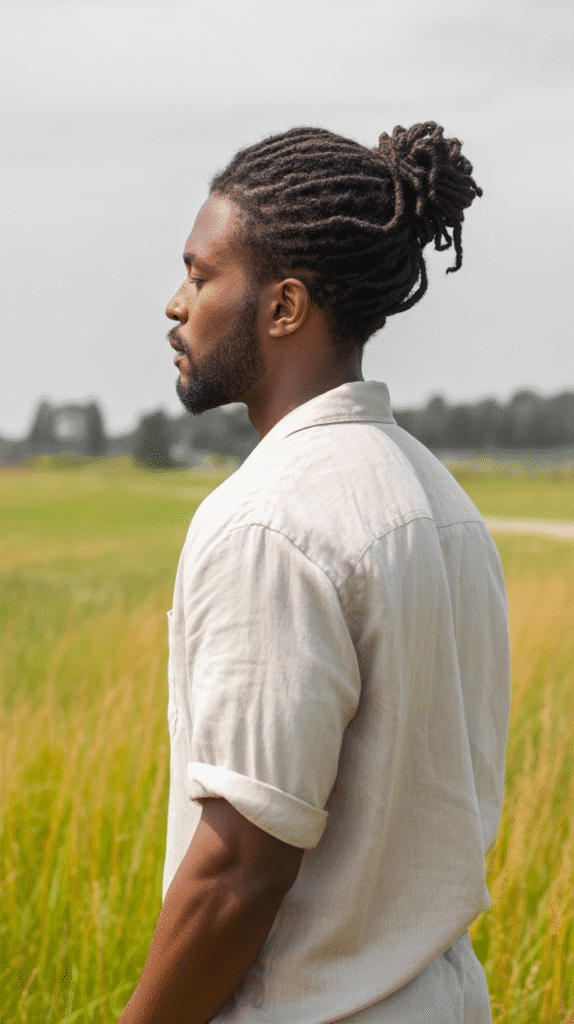
The dreadlock man bun represents effortless sophistication, pulling your locs away from your face while maintaining a relaxed, confident aesthetic.
This versatile style transitions seamlessly from casual daywear to evening events, making it perfect for the modern man with a dynamic lifestyle.
- Position the bun high on your crown for a more casual, athletic appearance or lower at the nape for a refined, professional look.
- This style provides relief from the weight of long locs on your neck and shoulders while preventing tangles during physical activities.
- Secure your man bun with elastic bands designed specifically for locs to prevent breakage and avoid excessive tension that could lead to traction alopecia.
- Leave a few strategic locs loose around your face to soften the look and add dimension to your overall style.
- The man bun works best with medium to long dreadlocks that are at least 6-8 inches in length for proper bundling.
3. Short Dreadlocks with Taper
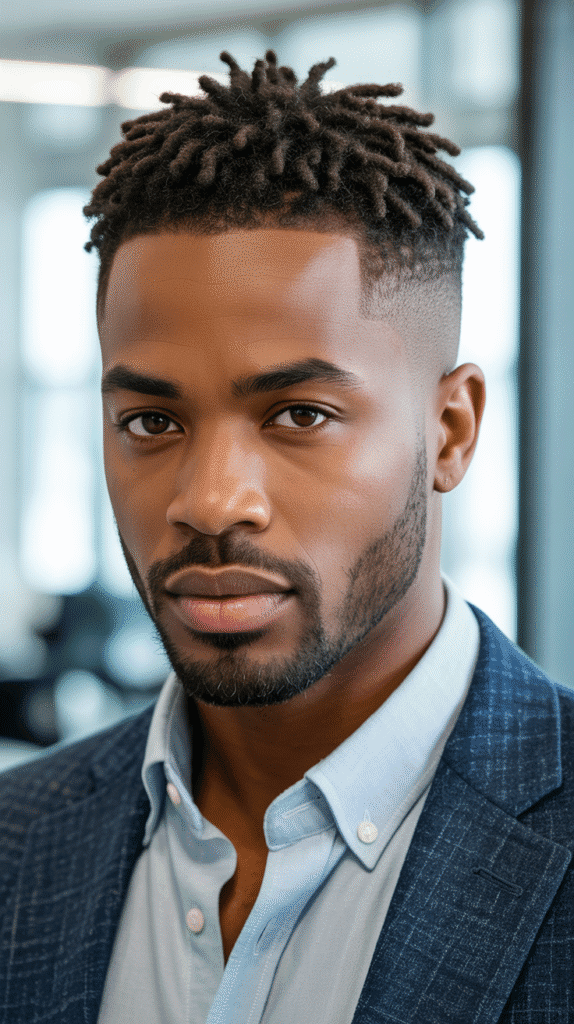
Short dreadlocks with a taper offer a professional, polished appearance that’s ideal for corporate environments while maintaining the cultural significance and texture of locs.
This style keeps your dreadlocks at a manageable 2-4 inch length while the tapered sides create clean definition.
- The tapered sides provide a graduated fade that seamlessly blends into your natural hairline, creating a polished transition.
- Short locs are significantly easier to maintain and dry faster after washing, making this an excellent choice for active lifestyles.
- This style minimizes the weight on your scalp and reduces the time commitment required for styling compared to longer dreadlocks.
- You can adjust the taper’s height to control how much contrast exists between your locs and the faded sections.
- Regular maintenance every 3-4 weeks keeps the taper sharp and prevents your locs from becoming too loose at the roots.
4. Freeform Dreadlocks
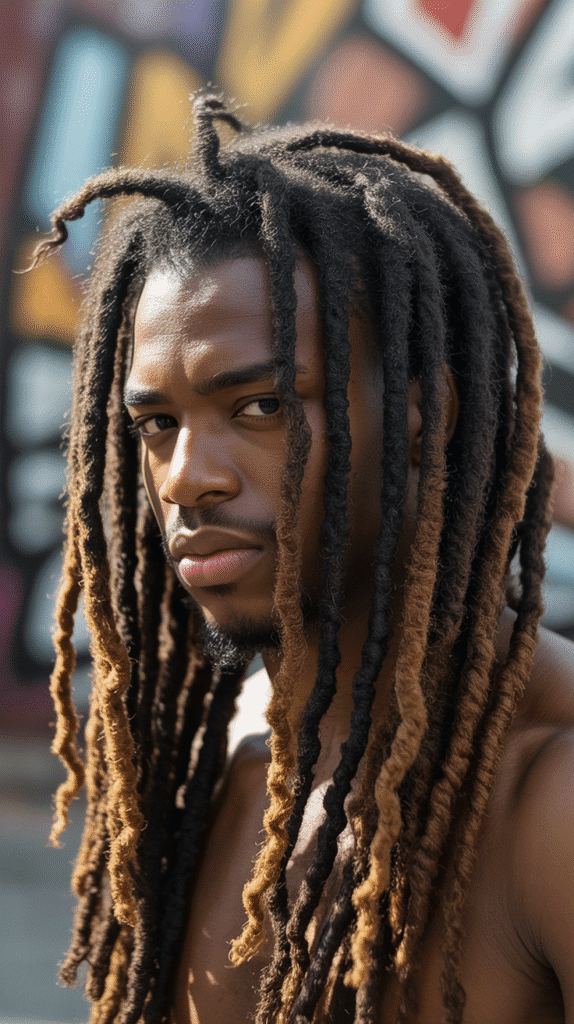
Freeform dreadlocks embrace the natural locking process without manipulation, allowing your hair to form organic patterns and unique textures.
This style celebrates authenticity and individuality, with each loc developing its own character, thickness, and shape over time.
- The freeform method requires minimal intervention, allowing your hair to lock naturally through washing and air-drying without palm rolling or twisting.
- Each loc develops independently, creating a truly one-of-a-kind appearance that cannot be replicated through traditional loc methods.
- This approach honors the original Rastafarian tradition of allowing hair to grow naturally as a spiritual practice.
- Freeform locs typically take 6-18 months to fully mature depending on your hair texture and density.
- While maintenance is minimal, regular washing with residue-free shampoo and occasional separating at the roots prevents locs from combining unintentionally.
5. Blonde Dreadlocks
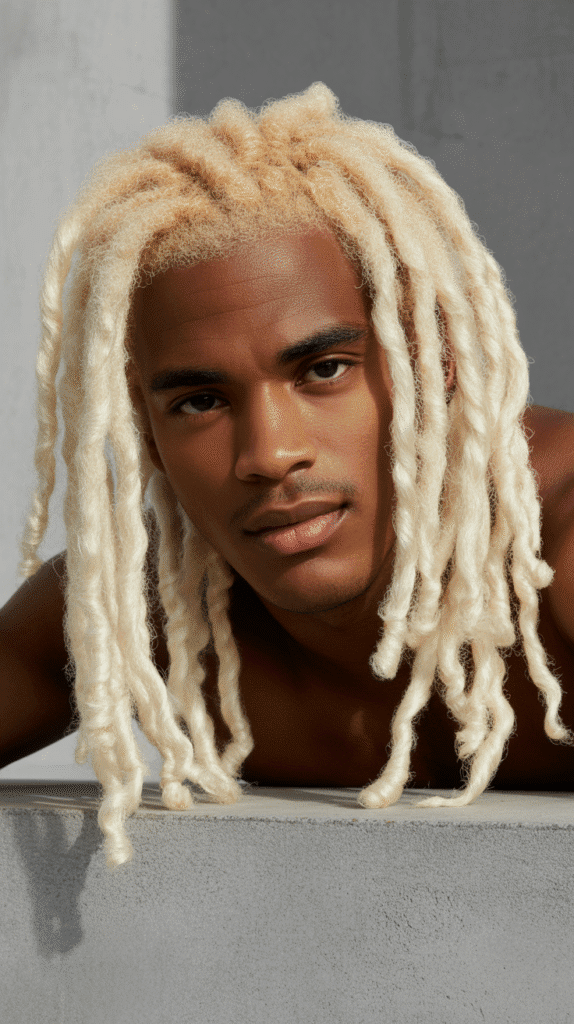
Blonde dreadlocks create a striking visual contrast that commands attention and showcases your bold personality.
This dramatic color transformation works on various skin tones and adds dimension to your locs through light-reflecting properties.
- Achieving blonde on naturally dark hair requires professional bleaching in multiple sessions to prevent severe damage to your locs.
- The porous nature of bleached dreadlocks necessitates intensive moisture treatments using oils like jojoba, argan, or coconut to maintain integrity.
- Blonde locs require purple or blue-toned shampoos to neutralize brassy yellow undertones that develop over time.
- This color shows dirt and buildup more readily than darker shades, requiring more frequent washing and careful product selection.
- The bold aesthetic of blonde dreadlocks pairs exceptionally well with minimalist fashion choices that let your hair become the focal point.
6. Dreadlock Ponytail
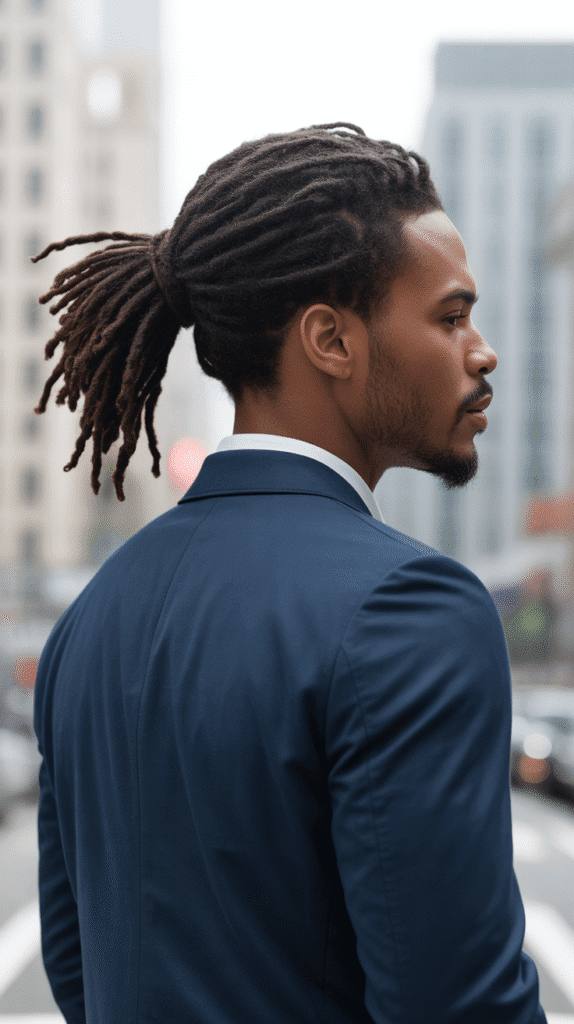
The dreadlock ponytail offers a sleek, streamlined look that keeps your locs secure and stylish throughout your daily activities.
This classic style works for any occasion, from gym sessions to formal gatherings, providing both functionality and fashion appeal.
- Position your ponytail at different heights to change your overall aesthetic—high for athletic vibes, mid-level for casual wear, or low for formal occasions.
- Use fabric-covered elastic bands or loc-specific ties that won’t snag or damage your hair’s structure.
- The ponytail provides an excellent protective style that minimizes manipulation and reduces daily wear on your locs.
- You can wrap one loc around the base of your ponytail to conceal the elastic band and create a more polished appearance.
- This style works best once your dreadlocks reach shoulder length or longer for adequate bundling without excessive tension.
7. Twisted Dreadlocks
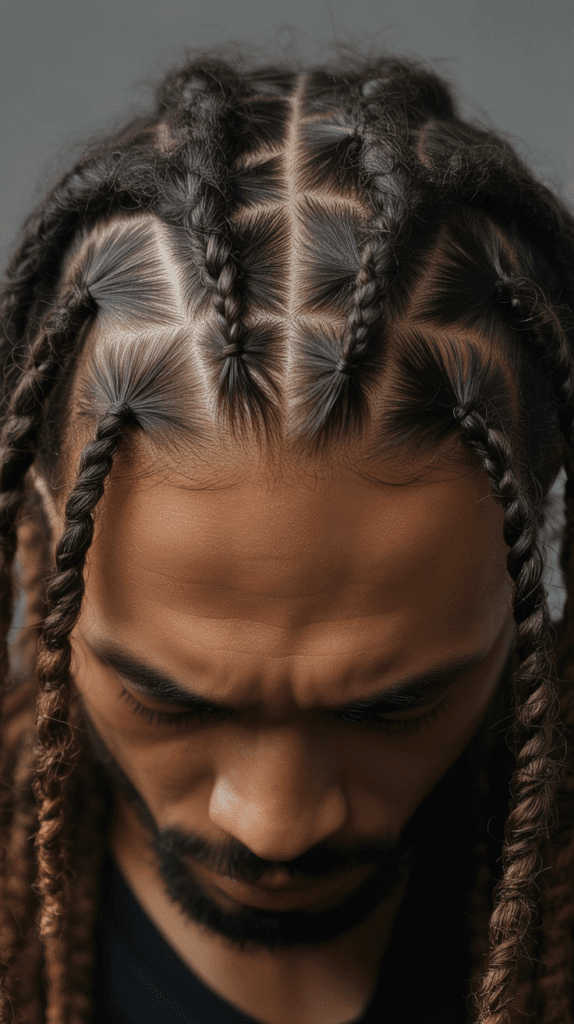
Twisted dreadlocks feature individual locs that are coiled or rope-twisted together in pairs or groups, creating unique patterns and adding dimensional texture.
This styling technique offers a refreshing departure from standard single locs while showcasing intricate detail work.
- Two-strand twists involve wrapping two adjacent locs around each other to create a rope-like appearance with enhanced definition.
- This technique can be applied to your entire head or used selectively to create patterns and designs within your overall loc style.
- Twisted locs appear fuller and thicker than single locs, making this an excellent option if you have thinner hair or fewer locs.
- The twisting process should be done on clean, slightly damp locs using a light holding gel to maintain the pattern as it dries.
- Twisted styles typically last 1-2 weeks before needing to be redone, making them ideal for special events or periodic style changes.
8. Undercut with Dreadlocks
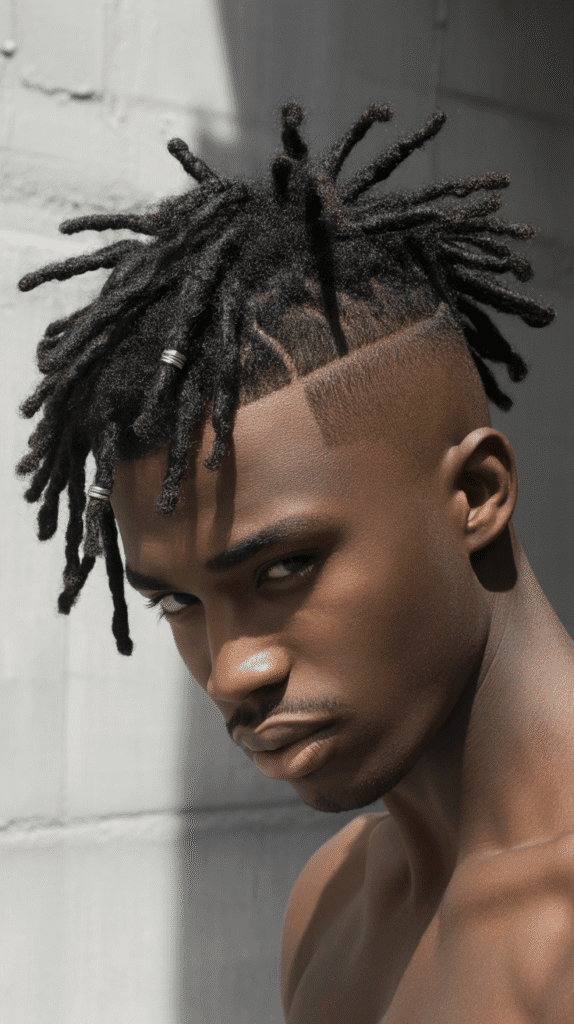
The undercut with dreadlocks creates bold contrast by completely removing hair from the sides and back while maintaining substantial length and volume on top.
This edgy style has surged in popularity among fashion-forward men seeking maximum visual impact.
- The undercut eliminates the need for fade maintenance as the shaved sections can be maintained with regular clippers at home.
- This style provides exceptional cooling during hot weather by removing hair from the sides while protecting your scalp on top.
- You can style the top locs in various ways including slicked back, swept to one side, or pulled into a top knot.
- The stark contrast works particularly well for men with thick, dense dreadlocks that create substantial weight and volume.
- Growing out an undercut requires patience as the transition period can be awkward, so commit to the style for several months.
9. Colored Tips Dreadlocks
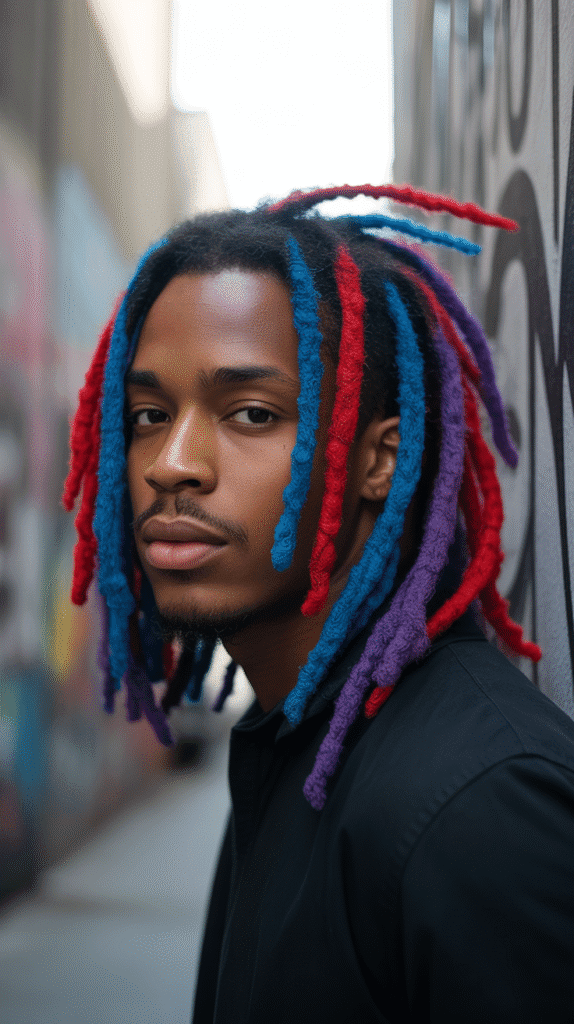
Colored tips dreadlocks offer a subtle introduction to color without the full commitment of dyeing your entire head.
This style adds playful dimension and allows for creative expression through strategic color placement at the ends of your locs.
- Tip coloring requires less bleaching and causes minimal damage compared to full-head color treatments since only the ends are processed.
- Popular color combinations include natural black roots transitioning to copper, burgundy, blue, purple, or even platinum tips.
- The color placement creates a gradient effect that adds depth and movement to your locs, especially when they’re in motion.
- You can trim off colored sections if you tire of the look without affecting your entire loc length or structure.
- Semi-permanent colors work well for tips, allowing you to experiment with different shades every few months without permanent commitment.
10. Long Dreadlocks
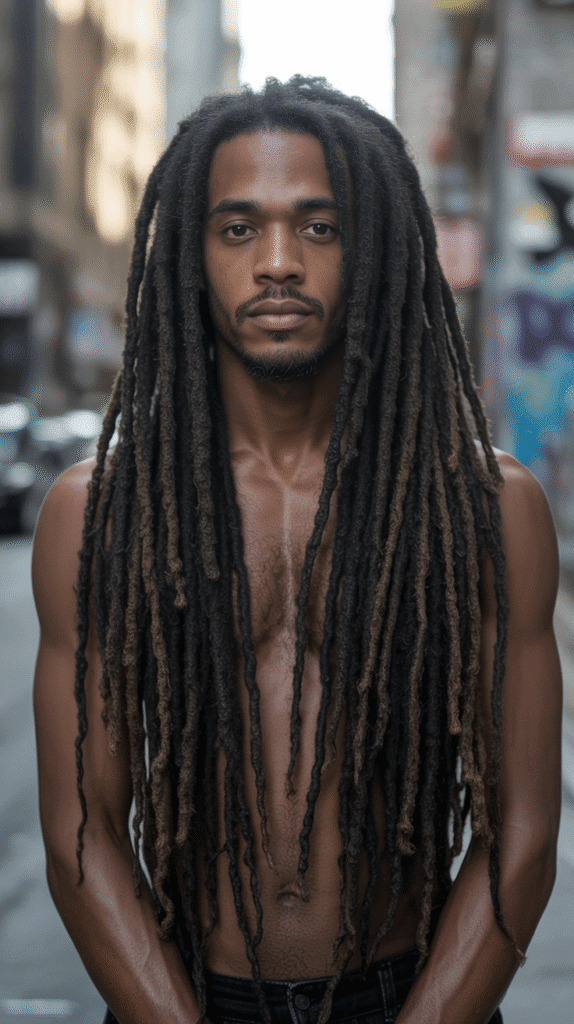
Long dreadlocks represent dedication and patience, often taking years to cultivate and becoming a defining aspect of your personal identity.
These flowing locs make a powerful statement and offer endless styling possibilities from their impressive length.
- Growing dreadlocks beyond shoulder length typically requires 3-5 years of consistent care and maintenance depending on your hair growth rate.
- Long locs become significantly heavier over time, which can cause tension on your scalp and may require regular breaks through updos.
- The weight of long dreadlocks naturally tightens and matures them, creating a more uniform texture and appearance throughout their length.
- Washing long locs requires extra time and attention to ensure thorough rinsing and complete drying to prevent mildew development.
- You can showcase the dramatic length through various styles including wearing them down, in braids, or elaborately wrapped updos.
11. Dreadlock Mohawk
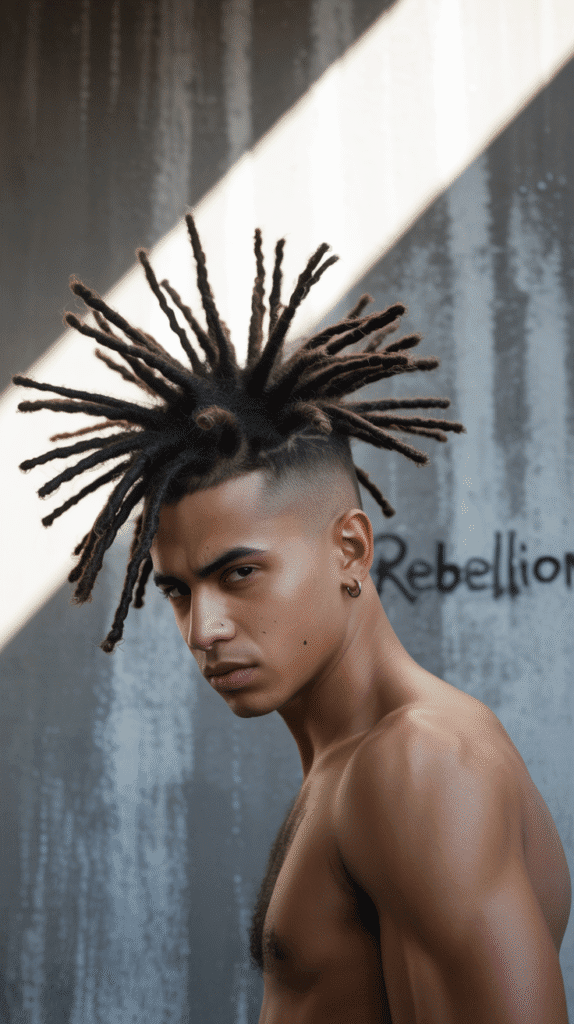
The dreadlock mohawk fuses punk rebellion with cultural tradition, creating an unmistakably bold statement.
This style features a central strip of dreadlocks running from your forehead to the nape while the sides are either shaved, faded, or kept very short.
- The width of your mohawk strip can range from 2 to 6 inches depending on how dramatic you want the contrast to be.
- Styling the locs to stand upright may require strong-hold products or creative pin-up techniques, especially if your locs are long.
- This style works exceptionally well for men with thick, healthy locs that have enough body to maintain the upright position.
- The mohawk can be styled in various ways including slicked back for a more refined appearance or spiked up for maximum impact.
- Regular maintenance of the shaved sections is essential to preserve the clean lines that make this style so striking.
12. Starter Locs
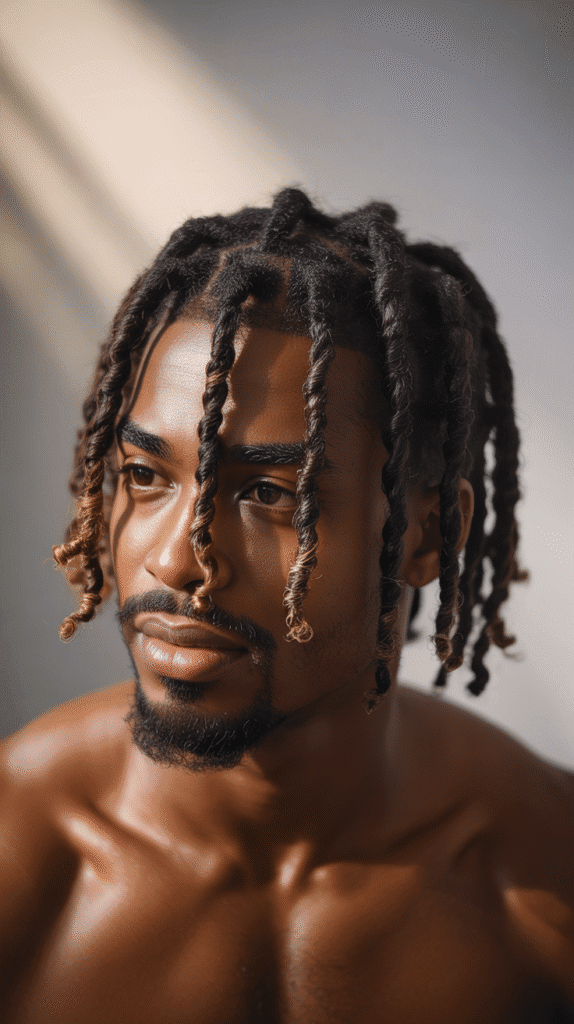
Starter locs represent the beginning of your dreadlock journey, showcasing the initial formation stage where your hair begins its transformation into locked coils.
This phase typically lasts 3-6 months and requires specific care techniques to encourage proper locking.
- Starter locs can be created through various methods including two-strand twists, comb coils, braids, or the freeform approach.
- This stage requires frequent maintenance every 2-4 weeks to keep your sections separated and encourage the hair to continue locking.
- Your locs will appear puffy and less defined during this phase as the hair is still in the coiling and budding process.
- Avoid heavy products during the starter phase to prevent buildup that can interfere with the natural locking process.
- Be patient with this stage as your locs will go through several phases before reaching full maturity at 18-24 months.
13. Triangle Pattern Dreadlocks
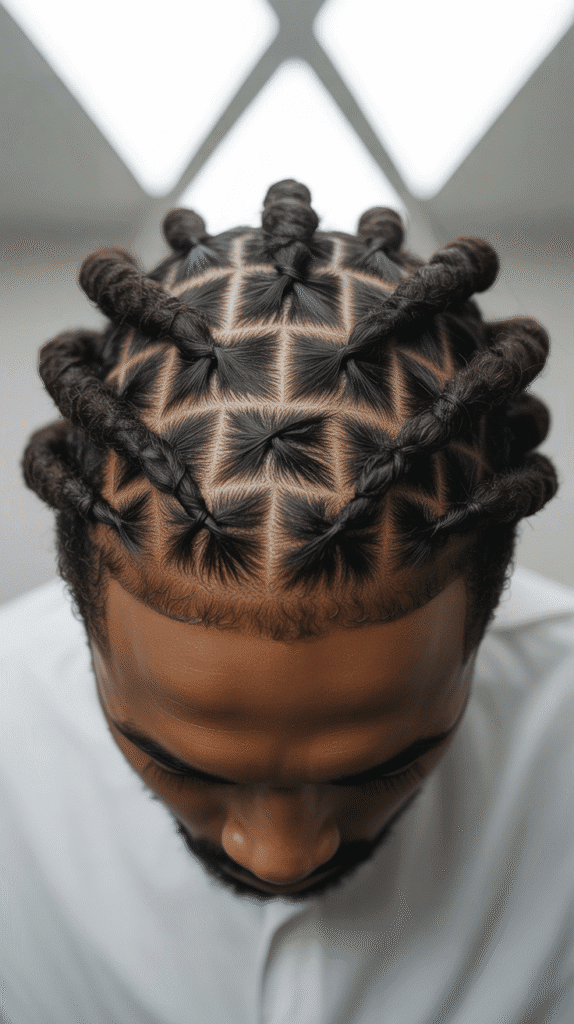
Triangle pattern dreadlocks feature precisely sectioned triangular parts that create geometric visual interest across your scalp.
This intentional parting system adds architectural dimension and showcases meticulous attention to detail in your loc formation.
- The triangle pattern prevents locs from merging at the roots by creating space between each section at multiple angles.
- This parting style works particularly well for thick, dense hair as it distributes the weight more evenly across your scalp.
- Creating triangle sections requires professional expertise during the initial loc installation to ensure symmetry and proper spacing.
- The geometric pattern becomes more visible as your locs mature and the roots tighten, revealing the intentional design.
- This sectioning method allows for more creative updo styles as the angular parts create interesting visual patterns when viewed from above.
14. Dreadlocks with Fade Design
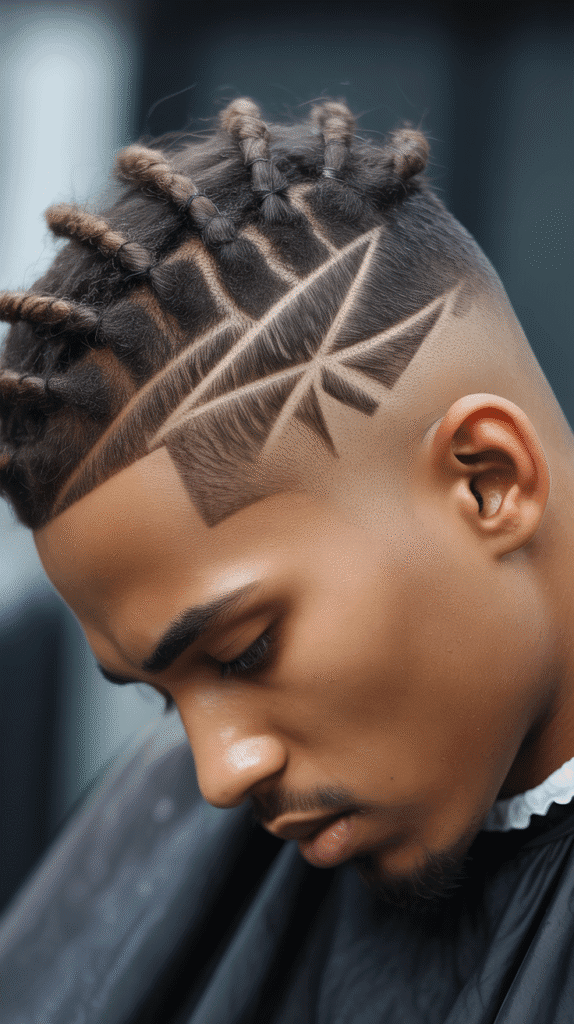
Dreadlocks with fade design incorporate artistic elements into the faded sections, transforming a simple fade into personalized artwork.
These designs can include lines, geometric patterns, symbols, or intricate illustrations that complement your locs.
- Popular design elements include straight lines, curves, waves, tribal patterns, or even logos and symbols that hold personal meaning.
- These designs require a skilled barber who specializes in hair artistry and can execute precise clipper work.
- Fade designs grow out within 1-2 weeks, requiring frequent touch-ups to maintain crisp, visible lines and patterns.
- The temporary nature of these designs allows you to experiment with different artistic expressions without permanent commitment.
- Consider the visibility of your design based on your loc length and whether they’ll cover the artwork when worn down.
15. Dreadlock Top Knot
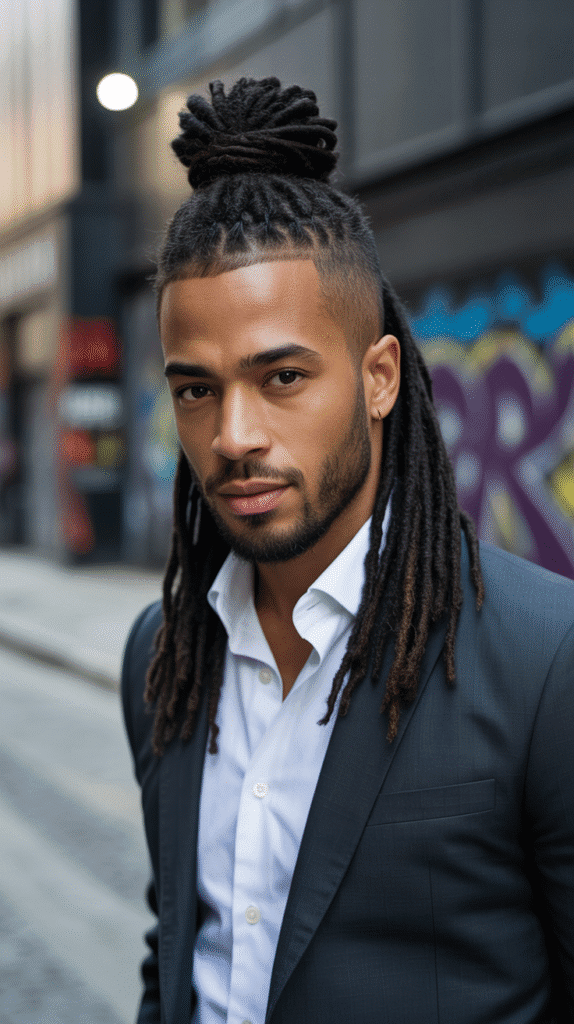
The dreadlock top knot gathers your locs into a bun positioned at the crown of your head, creating a commanding vertical element that exudes confidence.
This style has roots in samurai aesthetics while fitting perfectly into contemporary fashion.
- The top knot position creates a focal point at the highest part of your head, drawing the eye upward and enhancing your stature.
- This style keeps locs completely off your neck and shoulders, providing maximum cooling and comfort during physical activities.
- Secure the knot with multiple hair ties or loc-friendly accessories to ensure stability throughout your day.
- The top knot works best with medium to long locs that have enough length to wrap and bundle at the crown effectively.
- You can leave the sides with short locs, faded, or undercut to amplify the dramatic effect of the elevated top knot.
16. Thick Dreadlocks
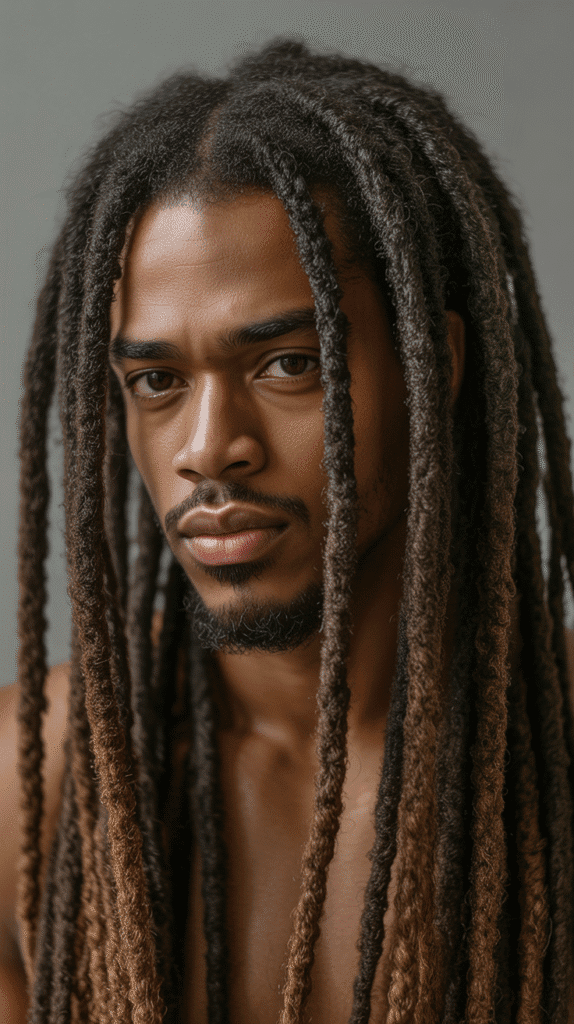
Thick dreadlocks feature individual locs with substantial diameter, creating a bold, robust appearance with fewer total locs on your head.
This style emphasizes volume and presence, making a strong visual statement through the sheer size of each loc.
- Thick locs typically range from 1 to 2 inches in diameter, requiring larger initial sections during the installation process.
- The substantial thickness means you’ll have fewer total locs (typically 20-40) compared to thin or medium-sized locs (which can number 100+).
- These locs lock and mature more slowly than thinner ones due to the greater volume of hair that needs to compress and tighten.
- The weight of thick locs can be substantial, especially as they grow longer, potentially causing tension on your scalp.
- Thick dreadlocks dry more slowly after washing, requiring thorough attention to prevent moisture retention and mildew.
17. Thin Dreadlocks
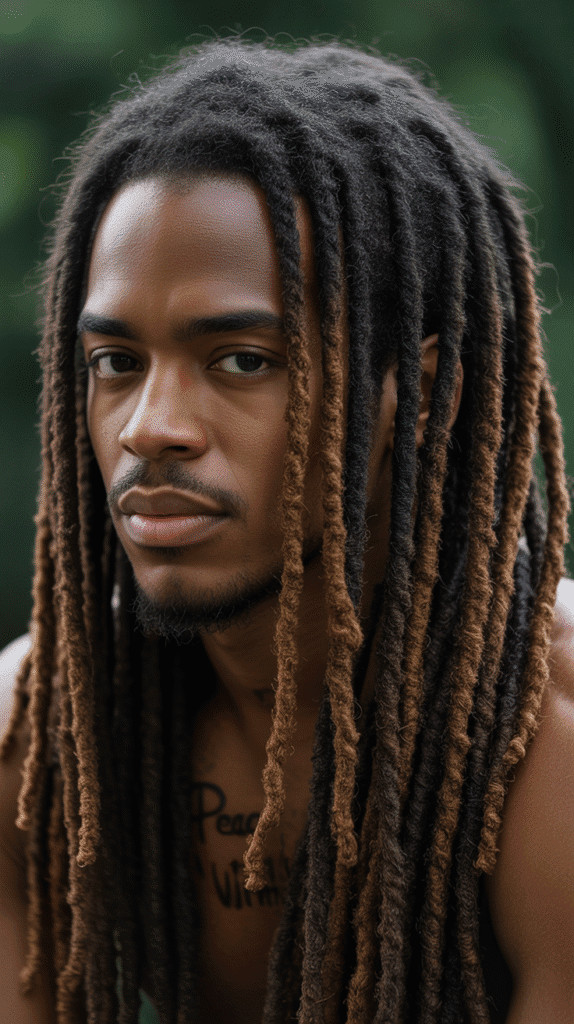
Thin dreadlocks consist of smaller-diameter locs that create a more delicate, refined appearance with greater number density across your scalp.
This style offers enhanced versatility for intricate styling and detailed pattern work.
- Thin locs typically measure between pencil-width and finger-width, resulting in 80-150+ individual locs depending on your hair density.
- The smaller diameter allows these locs to lock and mature faster than thick locs, often reaching full maturity in 12-18 months.
- Thin dreadlocks offer exceptional styling flexibility for braids, twists, and elaborate updo designs due to their manageable size.
- The lighter weight of individual thin locs reduces scalp tension and makes them more comfortable for extended wear.
- These locs dry much faster after washing, reducing the risk of mildew and making maintenance more convenient.
18. Dreadlock Braid Styles
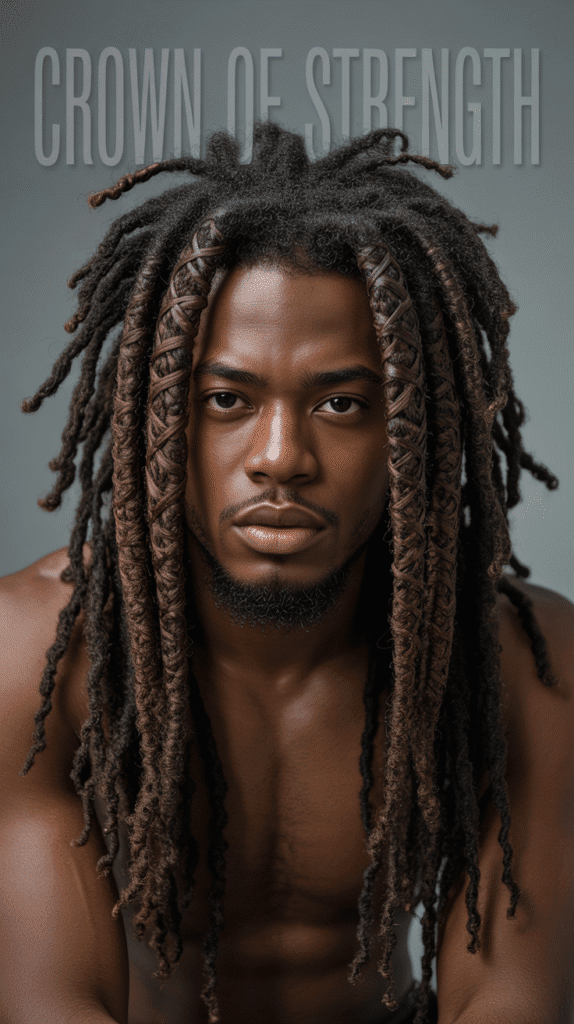
Dreadlock braid styles incorporate traditional braiding techniques into your locs, creating dimensional patterns and textured designs.
This fusion approach combines the permanence of dreadlocks with the versatility of braided styling for unique aesthetic appeal.
- You can braid your dreadlocks individually into patterns such as cornrows along your scalp or braid multiple locs together for thicker designs.
- French braiding several locs together creates a rope-like effect that adds substantial dimension and visual interest.
- Braided loc styles typically last 1-2 weeks before needing adjustment, making them ideal for vacations or special occasions.
- The braiding process works best on locs that are at least 6 inches long to provide adequate length for proper pattern formation.
- Use minimal product when braiding to avoid buildup and ensure your locs can breathe properly while styled.
19. Red Dreadlocks
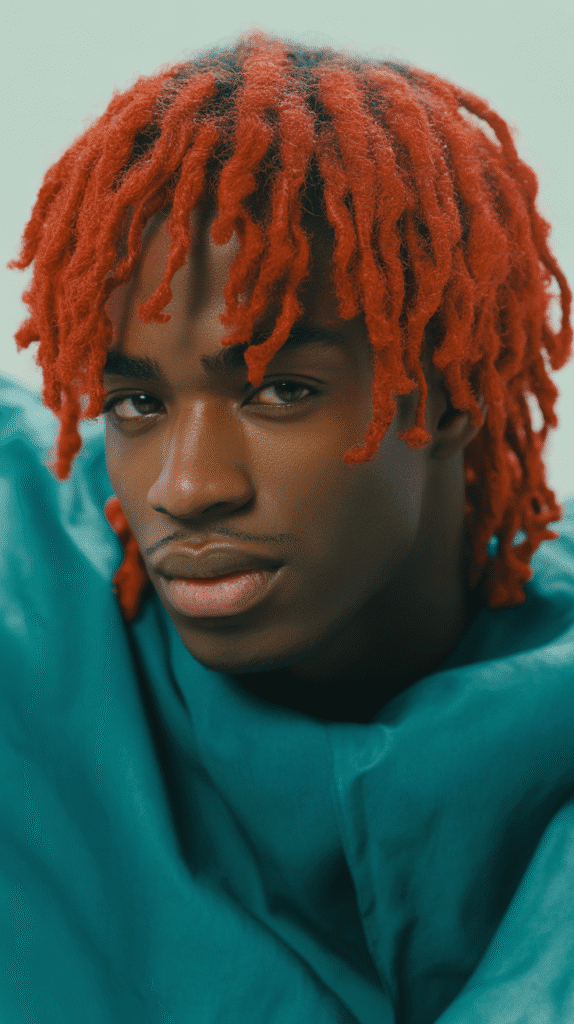
Red dreadlocks make a fiery, passionate statement through vibrant color that ranges from subtle auburn to brilliant crimson.
This bold color choice showcases confidence and creativity while adding warmth and dimension to your overall appearance.
- Red tones can be achieved through semi-permanent dyes on darker hair or may require bleaching for more vibrant, true-red results.
- The color red fades faster than many other shades, requiring color refresh treatments every 4-6 weeks to maintain vibrancy.
- Different red tones complement various skin undertones—copper and auburn suit warm undertones while burgundy works well with cool undertones.
- Red-colored locs benefit from color-safe, sulfate-free shampoos that prevent premature fading and maintain color integrity.
- The bold nature of red dreadlocks pairs well with neutral clothing colors like black, white, gray, and denim that let your hair shine.
20. Dreadlocks with Beads
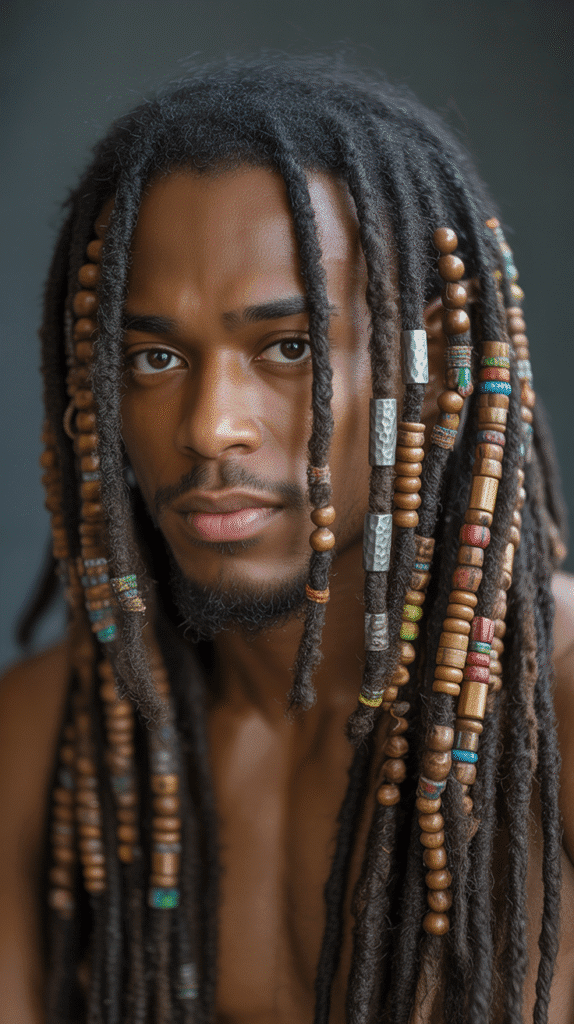
Dreadlocks with beads incorporate decorative elements that add cultural significance, personal meaning, and visual interest to your locs.
These accessories transform your hair into wearable art while honoring traditional African hair adornment practices.
- Beads can be made from wood, metal, glass, stone, or clay, each material offering different aesthetic and cultural significance.
- Thread beads onto individual locs or groups of locs, positioning them at various heights to create rhythm and visual flow.
- Ensure beads have openings large enough to slide onto your locs without excessive force that could cause damage or breakage.
- The weight of numerous heavy beads can strain your locs and scalp, so balance decorative desire with practical comfort.
- Beads can be repositioned, added, or removed easily, allowing you to refresh your look without permanent changes to your locs.
21. Dreadlock Half-Up Style
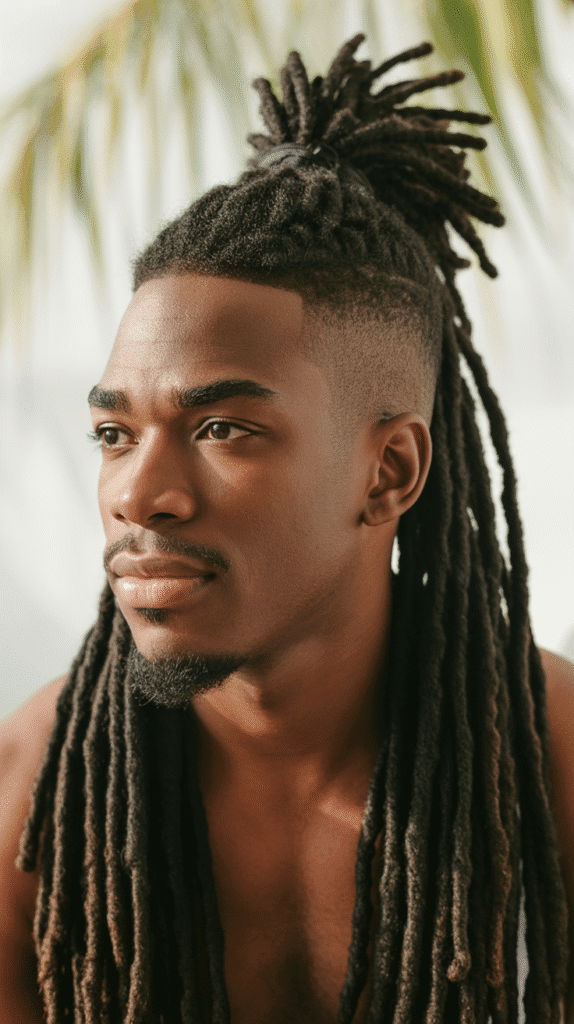
The dreadlock half-up style divides your locs between secured upper sections and free-flowing lower portions, creating balanced dimension that’s both practical and stylish.
This versatile approach offers the best of both worlds for various occasions and settings.
- Pull the top half or third of your locs into a bun, ponytail, or twist while allowing the remainder to cascade naturally down your back.
- This style keeps hair away from your face for visibility and comfort while showcasing the length and flow of your locs.
- The half-up approach works exceptionally well for medium to long locs that benefit from partial containment without full restriction.
- You can customize the style by adjusting how much hair you secure upward and choosing different fastening methods for varied aesthetics.
- This versatile option transitions seamlessly from professional daytime wear to casual evening settings with minimal adjustment.
22. Dreadlocks with Side Part
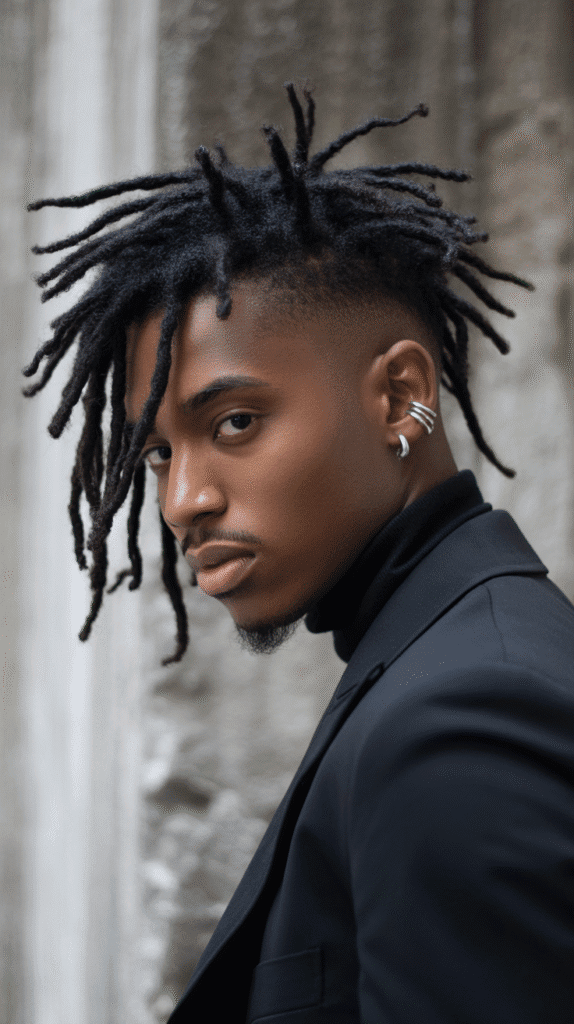
Dreadlocks with a side part create asymmetrical elegance by dramatically sweeping your locs to one side of your head.
This classic styling technique adds sophistication and draws attention to your facial features through directional flow.
- Create a clean part line using a comb or your fingers, positioning it anywhere from slightly off-center to dramatically to one side.
- The side part works best with medium to long locs that have enough weight and length to naturally fall in the desired direction.
- Secure the swept section with bobby pins or small clips if needed to maintain the style throughout your day.
- This approach offers a refreshing alternative to center-parted or back-swept styles while maintaining professional appeal.
- The side part can be switched to either side based on your preference or to give consistently styled locs a break from tension.
23. Shoulder-Length Dreadlocks
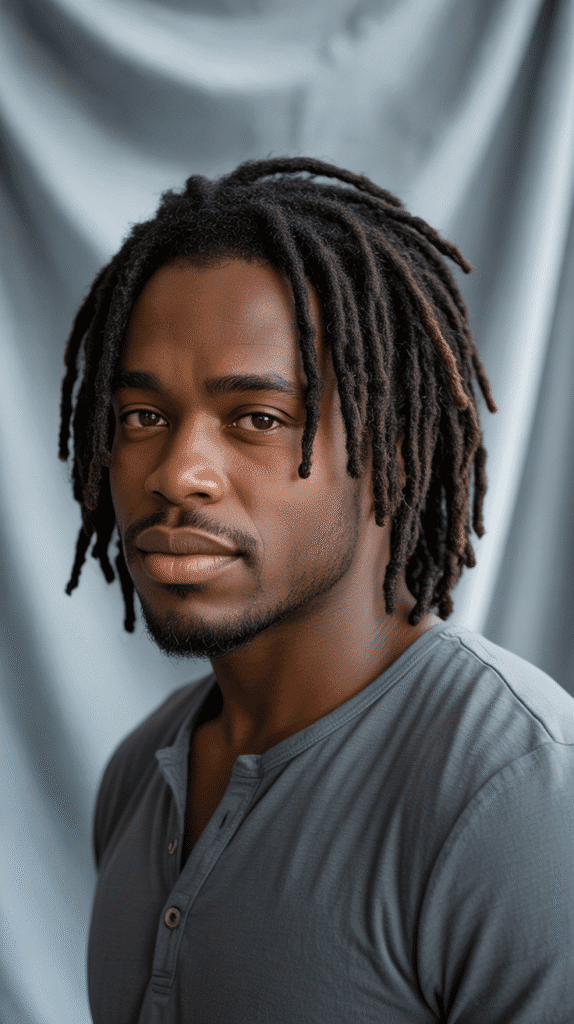
Shoulder-length dreadlocks represent the ideal middle ground between manageability and visual impact, offering substantial length without the extreme weight and maintenance of very long locs.
This versatile length suits most face shapes and lifestyle requirements.
- Shoulder-length locs typically measure 12-16 inches and require approximately 2-3 years to grow from starter locs depending on growth rate.
- This length offers excellent styling versatility including ponytails, buns, half-up styles, and wearing them down comfortably.
- The moderate weight of shoulder-length locs provides enough density to pull them naturally down while remaining manageable for daily activities.
- Drying time after washing sits in a comfortable middle range, typically requiring 4-6 hours with proper wringing and air circulation.
- This length remains professional enough for most workplace environments while providing sufficient impact for personal expression.
24. Dreadlock Bun
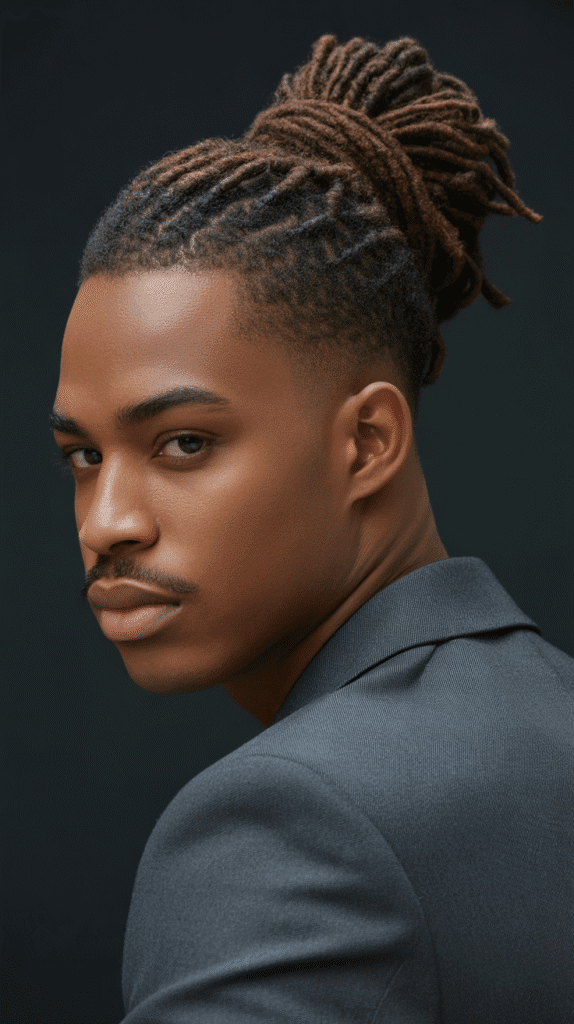
The dreadlock bun represents timeless elegance and practicality by gathering all your locs into a rounded bundle positioned anywhere from your crown to your nape.
This classic style suits virtually any setting from casual to formal occasions.
- Create different impressions by positioning your bun high for casual youthfulness, mid-level for balanced versatility, or low for formal sophistication.
- Wrap your locs around themselves in a circular pattern, securing with loc-safe elastic bands or decorative hair sticks.
- The fully contained bun protects your locs from environmental damage and reduces daily manipulation that can cause wear.
- For very long or thick locs, consider using multiple securing points to distribute weight and prevent the bun from sagging.
- The bun works as an excellent protective style during sleep, exercise, or activities where loose locs would be impractical.
25. Dreadlocks with Shaved Sides
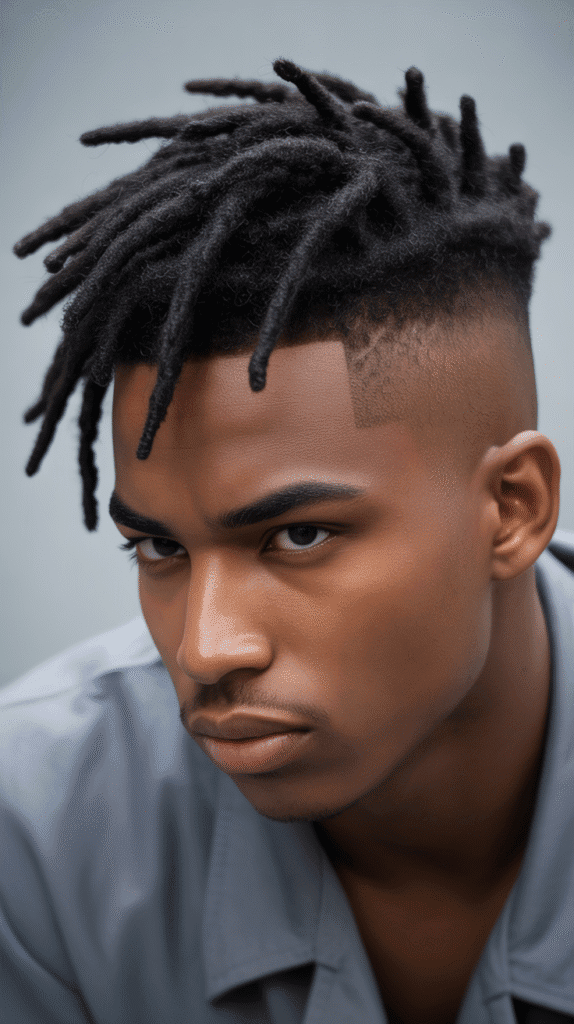
Dreadlocks with shaved sides create striking contrast by removing hair completely from the sides while maintaining full locs on top and back.
This modern interpretation balances edgy aesthetics with practical temperature control and reduced maintenance.
- The shaved sides eliminate the need for loc maintenance on those sections, reducing your overall hair care routine significantly.
- This style provides exceptional cooling during warm weather while concentrating visual impact on the remaining locs.
- You can adjust how much of the sides to shave, from just the temples to extending well above your ears for maximum contrast.
- Regular home maintenance with clippers keeps the shaved sections clean without requiring professional barber visits.
- The remaining locs gain additional emphasis and appear fuller due to the stark contrast with the bare sides.
26. Ombre Dreadlocks
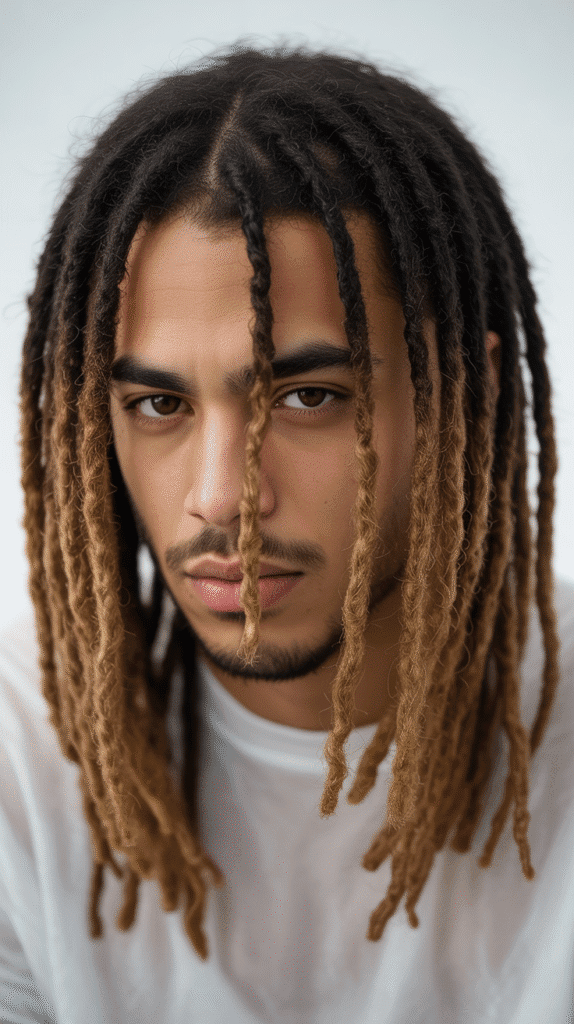
Ombre dreadlocks feature graduated color transitions from dark roots to lighter ends, creating dimensional depth that adds sophistication and visual interest.
This coloring technique provides contemporary fashion appeal while requiring less frequent maintenance than solid color.
- The gradual color transition minimizes the appearance of root growth, extending the time between color touch-ups significantly.
- Popular ombre combinations include black to brown, brown to blonde, or natural shades to vibrant colors like red or copper.
- The lightening process requires professional bleaching to achieve even color distribution without excessive damage to your locs.
- Ombre coloring adds perceived dimension and movement to your locs, especially when light hits the varied tones.
- The darker roots provide a low-maintenance color option since natural growth blends seamlessly with the intentional design.
27. Dreadlock Crown Style
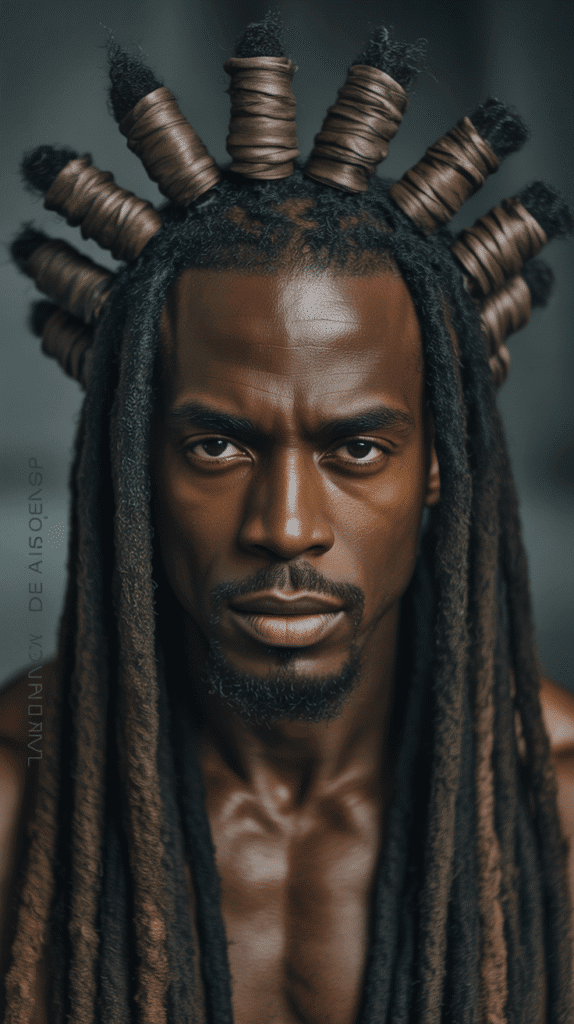
The dreadlock crown style wraps your locs in circular patterns around your head, creating a regal, halo-like effect that honors African royalty aesthetics.
This elaborate styling technique showcases the length and flexibility of mature locs through intricate arrangement.
- The crown style works best with long, flexible locs that can be wrapped and pinned without excessive tension or breakage.
- Create the crown by sectioning your locs and wrapping them horizontally around your head, securing with bobby pins or decorative accessories.
- This protective style keeps locs completely contained and away from environmental elements while making an impressive visual statement.
- The crown can be created in single or multiple tiers depending on your loc length and thickness, adjusting complexity to your preference.
- This elaborate style is ideal for special occasions, cultural events, or formal settings where you want to make a memorable impression.
28. Messy Dreadlock Style
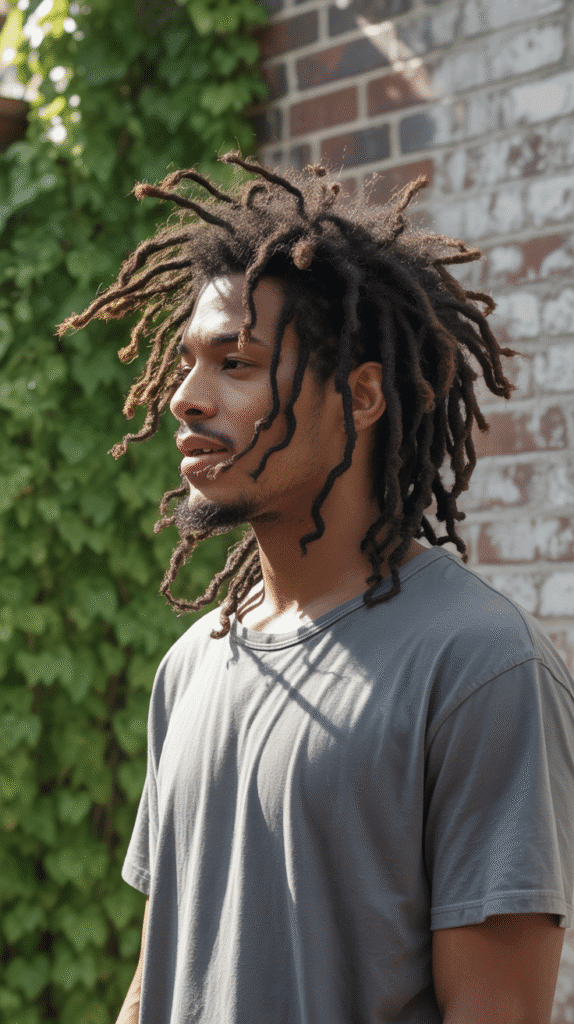
The messy dreadlock style embraces organic, carefree aesthetics through intentionally tousled locs that project effortless cool.
This relaxed approach rejects rigid styling in favor of natural texture and movement that feels authentic and unforced.
- Achieve this look by allowing your locs to fall naturally without smoothing, arranging, or containing them in structured patterns.
- The messy aesthetic works particularly well with freeform or semi-freeform locs that have varied thickness and organic shapes.
- This style requires the least daily maintenance of any loc style, simply needing occasional separation at roots and regular cleansing.
- The relaxed appearance suits creative, artistic, or casual environments where rigid grooming standards don’t apply.
- Despite the messy appearance, maintaining loc health through proper washing and moisturizing remains essential for long-term integrity.
29. Dreadlocks with Hair Accessories
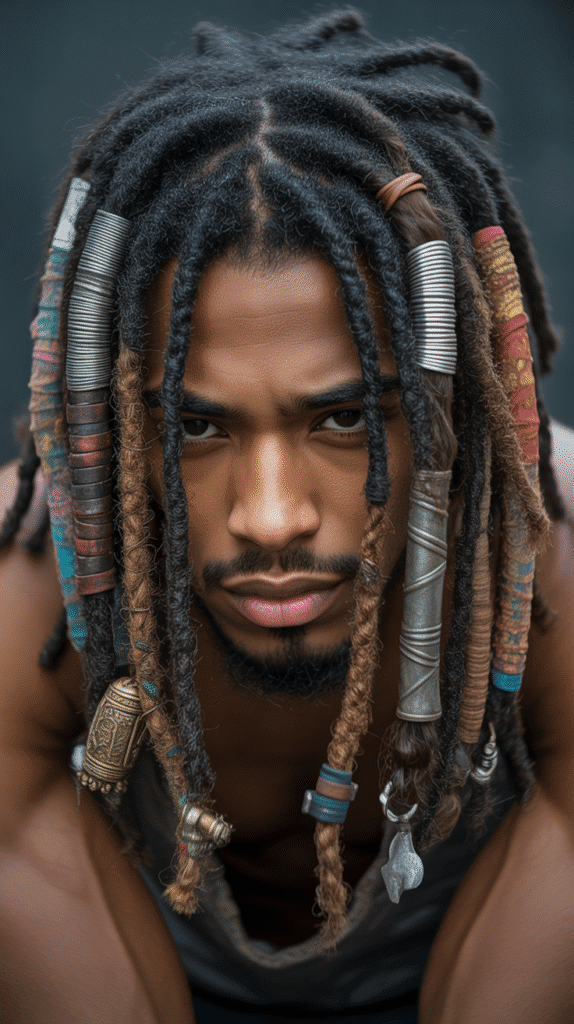
Dreadlocks with hair accessories elevate your style through strategic placement of decorative elements including wraps, cuffs, rings, and fabric.
These additions transform your locs into customized artistic expressions that reflect your personality and cultural connections.
- Metal loc cuffs slide onto individual locs at various positions, adding shine, texture, and weight that enhances movement.
- Fabric wraps can partially or completely cover locs, introducing color patterns and protecting sections from environmental exposure.
- Leather ties and strings can secure bundles of locs together or create decorative accent points throughout your style.
- Hair jewelry including rings, charms, and pendants thread onto locs to add personal meaning through symbolic elements.
- Rotate accessories regularly to prevent permanent indentations or weak spots from developing at consistent pressure points.
30. Short Freeform Dreadlocks
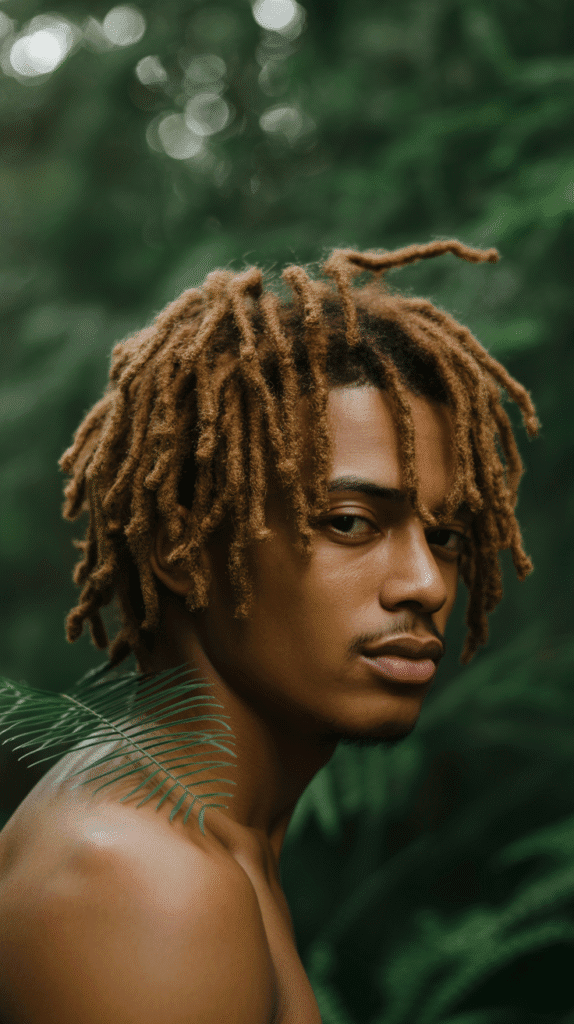
Short freeform dreadlocks combine the organic development process of freeform locs with the manageability and professionalism of shorter length.
This style offers authentic texture while maintaining practical length for various lifestyle requirements.
- These locs typically measure 3-6 inches in length, providing enough substance to display the freeform character without excessive weight.
- The shorter length accelerates the initial locking process compared to longer freeform locs, reaching maturity faster.
- Short freeform locs suit professional environments better than longer versions while maintaining the authentic freeform aesthetic.
- The manageable length simplifies washing, drying, and general maintenance while reducing product usage and care time.
- This style represents an excellent transition option if you’re growing out your locs from very short or testing the freeform method.
31. Dreadlocks with Cornrow Base
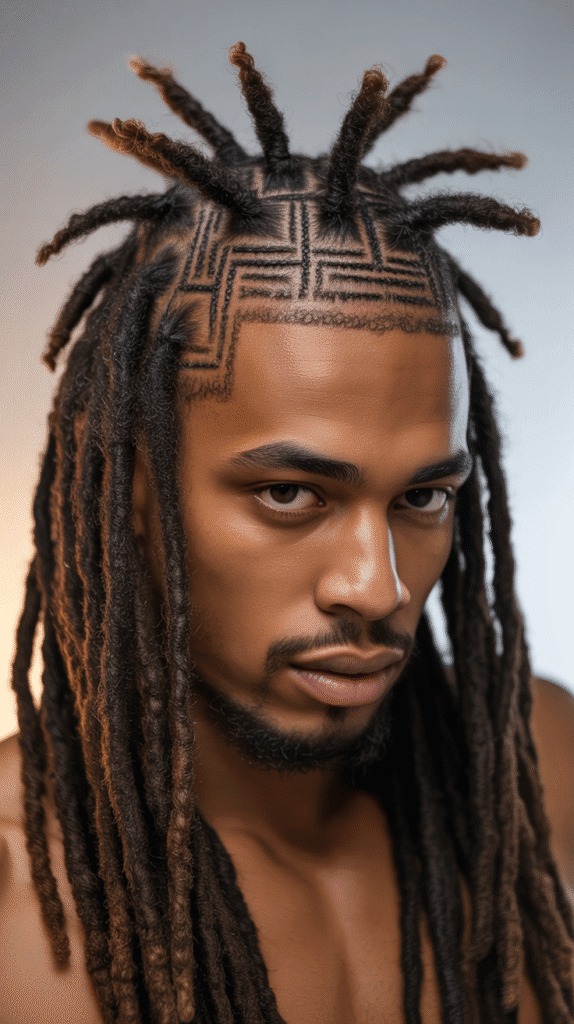
Dreadlocks with a cornrow base feature braided sections at the scalp that transition into free-hanging locs, creating dimensional contrast between flat-braided roots and cylindrical locs.
This hybrid technique adds intricate detail to your overall style.
- The cornrow sections can form simple straight-back patterns or elaborate designs including curves, zigzags, or geometric shapes.
- This technique provides a protective styling benefit by securing the roots and reducing tension on individual loc bases.
- Cornrow bases typically last 2-4 weeks before requiring re-braiding, making them suitable for temporary style changes.
- The flat braided sections lay smoothly against your scalp, reducing bulk and providing cooling relief during warm weather.
- This style works best with mature locs that have enough root flexibility to braid without excessive tension or breakage.
32. Two-Tone Dreadlocks
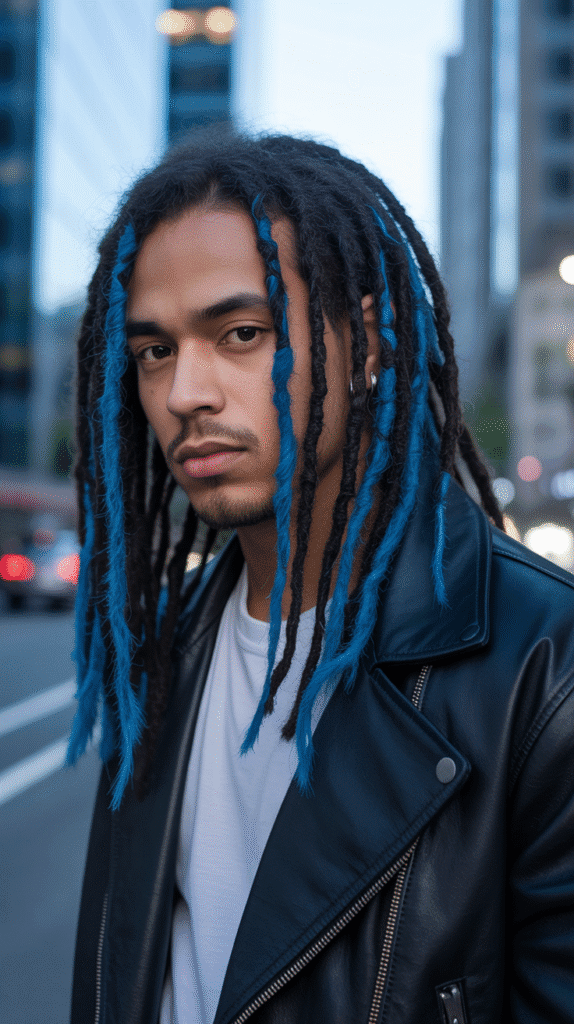
Two-tone dreadlocks feature distinct color blocking with sharp transitions between two different shades, creating bold visual impact through dramatic contrast.
This coloring approach makes an uncompromising fashion statement that demands attention.
- Popular two-tone combinations include black and blonde, brown and red, or contrasting vibrant shades like blue and orange.
- The color division can occur horizontally (top versus bottom), vertically (left versus right), or alternating between individual locs.
- Achieving distinct color separation requires careful application and possibly multiple processing sessions for clean transitions without bleeding.
- This bold color choice works best for creative professionals, artists, or individuals in environments that embrace expressive personal styling.
- Maintaining two-tone locs requires color-safe products and separate treatments for each color to preserve vibrancy and prevent fading.
33. Dreadlocks with Temple Fade
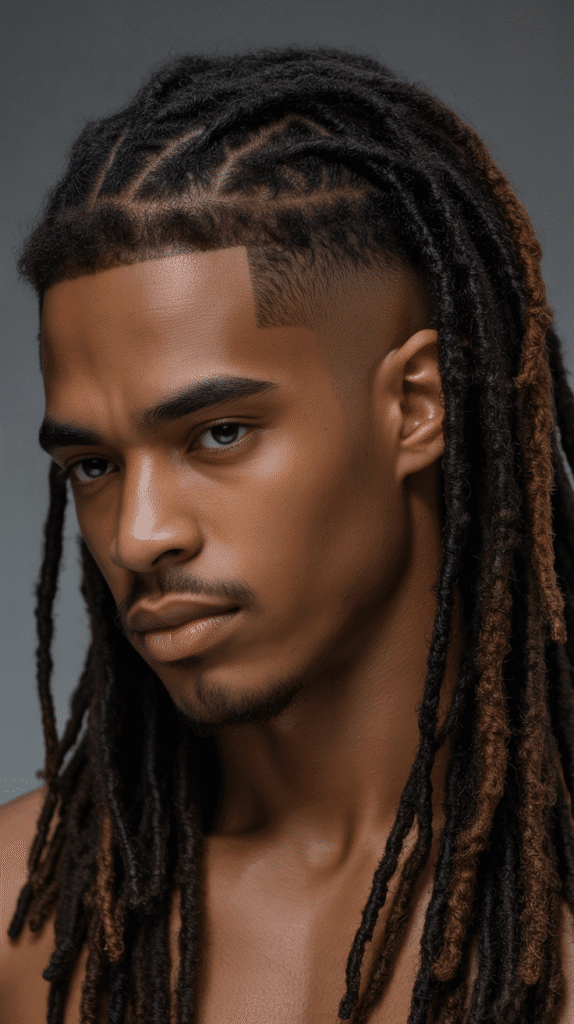
Dreadlocks with temple fade specifically targets the temple areas with graduated fading while leaving other sections intact, creating subtle refinement without the commitment of full side fades.
This conservative approach maintains volume while adding definition.
- The temple fade focuses on the areas directly in front of and above your ears, gradually blending down to skin or very short hair.
- This targeted approach maintains more hair volume overall compared to full side fades while still providing clean, defined edges.
- Temple fades suit professional environments perfectly, offering groomed appearance without dramatic styling that might seem too casual.
- The limited fade area requires less frequent maintenance compared to full fades, needing touch-ups every 3-4 weeks.
- This style works particularly well for men with receding hairlines as the fade creates clean definition .
- You can gradually expand the temple fade’s scope over time if you want to transition toward more extensive fading without dramatic immediate change.
- The subtle nature of temple fades allows you to test faded styles before committing to more dramatic undercuts or high fades.
Maintenance Tips for All Dreadlock Styles
Regardless of which dreadlock style you choose from the 33 options above, proper maintenance ensures your locs remain healthy, attractive, and long-lasting.
Understanding the fundamental care requirements helps you preserve your investment of time and effort.
- Use residue-free shampoos specifically formulated for dreadlocks to prevent product buildup that can cause mildew and odor.
- Allow your locs to dry completely after washing, which may take 6-12 hours depending on thickness and length—never bundle wet locs.
- Apply lightweight oils like jojoba, sweet almond, or grapeseed to your scalp and locs to maintain moisture without creating heavy buildup.
- Avoid heavy waxes, gels, or petroleum-based products that attract lint and dirt while preventing proper drying and breathing.
- Protect your locs during sleep by wearing a silk or satin bonnet, durag, or sleeping on silk pillowcases to reduce friction and frizz.
- Separate your locs at the roots regularly during the first year to prevent them from merging together unintentionally.
- Schedule professional maintenance appointments every 4-8 weeks for retwisting, tidying, or addressing any problem areas that develop.
Choosing the Right Dreadlock Style for Your Face Shape
Selecting a dreadlock style that complements your facial structure enhances your overall appearance and creates harmonious proportions.
Different styles work better with specific face shapes, so understanding these relationships helps you make informed decisions.
- Round faces benefit from high top styles, mohawks, or vertical emphasis that adds length and creates the illusion of elongation.
- Square faces work well with softer, longer loc styles that fall around the face, softening strong jawlines and adding gentle framing.
- Oval faces can accommodate virtually any dreadlock style as the balanced proportions work with most configurations.
- Heart-shaped faces look excellent with styles that add width at the jawline, such as shoulder-length locs worn down or half-up styles.
- Long faces pair well with fuller, wider styles or side-swept locs that add horizontal dimension and balance vertical length.
- Diamond faces benefit from styles that add width at the forehead or chin, such as forward-swept locs or fuller temple areas.
- Consider your hairline characteristics—receding temples work better with styles that include fades or strategic forward placement of locs.
Products Essential for Dreadlock Care
Quality products specifically designed for dreadlocked hair make the difference between healthy, attractive locs and problematic, damaged ones.
Investing in proper care products protects your hair investment and simplifies maintenance routines.
- Residue-free shampoo cleanses without leaving buildup that can create mildew—look for products specifically labeled for dreadlocks.
- Lightweight moisturizing oil such as jojoba, argan, or sweet almond oil maintains moisture balance without creating greasy residue.
- Loc gel or cream provides hold during styling and retwisting without the heavy buildup associated with traditional waxes.
- Apple cider vinegar diluted with water creates an effective clarifying rinse that removes buildup and restores pH balance monthly.
- Silk or satin bonnet protects locs during sleep by reducing friction that causes frizz and helps maintain moisture.
- Loc-safe elastic bands use fabric covering or soft materials that won’t snag or damage your locs during styling.
- Spray bottle filled with water and light oil creates a refreshing mist for daily moisture maintenance between washes.
Common Dreadlock Mistakes to Avoid
Understanding common pitfalls helps you sidestep problems that could compromise your locs’ health, appearance, or longevity.
Learning from others’ mistakes prevents frustration and protects your hair investment.
- Over-washing strips natural oils and causes excessive dryness—stick to washing every 7-10 days unless you have exceptional circumstances.
- Using wax products creates sticky buildup that attracts lint, prevents proper drying, and can never be fully removed from mature locs.
- Retwisting too frequently causes thinning at the roots and can lead to breakage—maintain a 4-6 week minimum between retwisting sessions.
- Neglecting to dry completely after washing creates the perfect environment for mildew growth that causes permanent odor problems.
- Making locs too tight at the roots during maintenance causes traction alopecia and permanent hair loss over time.
- Skipping scalp care leads to dryness, itching, and dandruff—maintain your scalp health with regular oiling and gentle massage.
- Cutting corners during the starter phase compromises the foundation of your locs, leading to weak structure and uneven maturation.
- Using regular hair ties causes breakage and damage—invest in loc-specific accessories designed to protect your hair’s structure.
How Long Does It Take to Grow Dreadlocks?
Understanding the timeline for dreadlock development helps you set realistic expectations and remain patient through the various growth and maturation stages.
Different factors influence how quickly your locs develop their full character.
- Starter phase (Months 0-3): Hair is twisted, coiled, or braided into initial loc formation with minimal actual locking occurring yet.
- Budding phase (Months 3-6): Locs begin to swell and appear puffy as the hair starts to tangle and knot within each section.
- Teen phase (Months 6-12): Locs experience significant frizz and irregular appearance as they continue tightening and finding their shape.
- Mature phase (Months 12-18): Locs develop consistent cylindrical shape with tightened cores, though some frizz may remain at the surface.
- Rooted phase (Months 18-24+): Locs reach full maturity with tight, uniform appearance and minimal frizz, representing complete development.
- Length development: Hair typically grows 4-6 inches annually, meaning shoulder-length locs require approximately 2-3 years from starting short.
- Texture affects timeline—coarser, kinkier hair types lock faster than straighter, finer textures which may take significantly longer.
- Method matters—traditional twist or comb coil methods produce faster results than freeform approaches which can take 12+ months to even begin.
Cultural Significance and Respect
Dreadlocks carry profound cultural, spiritual, and historical significance across multiple traditions worldwide.
Understanding and respecting these roots adds depth to your personal choice while honoring the communities that developed these styles.
- Dreadlocks have ancient origins in various cultures including ancient Egypt, India, Greece, and indigenous populations across multiple continents.
- Rastafarian tradition views dreadlocks as a spiritual covenant, with biblical references including the Nazarite vow and Samson’s uncut hair.
- The term “dreadlocks” itself has debated origins, with some attributing it to the “dread” felt by colonizers seeing locked hair, while others connect it to “dread” meaning respect or fear of God in Rastafari.
- African cultures have utilized locked, braided, and twisted hairstyles for thousands of years, with different styles indicating tribal affiliation, social status, or spiritual beliefs.
- Hindu sadhus and practitioners in India have worn jata (locked hair) for millennia as symbols of spiritual devotion and renunciation of material concerns.
- Wearing dreadlocks as a non-Rastafarian or outside of specific cultural contexts is acceptable when done with respect, understanding, and appreciation rather than appropriation.
- Educate yourself about the cultural significance and be prepared to engage respectfully with questions about your choice to wear this historically meaningful style.
- Support authentic cultural practitioners, businesses, and educators within dreadlock communities rather than appropriating styles without acknowledgment or understanding.
Professional Settings and Dreadlocks
Modern workplace acceptance of dreadlocks has evolved significantly, though navigation of professional environments still requires awareness and sometimes strategic styling choices.
Understanding how to present your locs professionally opens opportunities while maintaining your authentic self-expression.
- Many progressive companies and industries now embrace natural hairstyles including dreadlocks as part of diversity and inclusion initiatives.
- Legal protections in various jurisdictions prohibit discrimination based on natural hair texture and protective styles including the CROWN Act in multiple U.S. states.
- Well-maintained locs with neat roots, clean appearance, and intentional styling read as professional in most modern workplace environments.
- Conservative industries like law, finance, or corporate settings may require more polished loc styles such as buns, ponytails, or shorter lengths.
- Creative fields including design, media, technology, and entertainment generally accept dreadlocks of all styles and lengths without restriction.
- Strategic styling for important meetings or presentations might include pulled-back styles, accessories that add polish, or temporarily conservative approaches.
- Document your work quality and professionalism through performance rather than appearance, building a reputation that transcends superficial judgments.
- Know your rights regarding workplace discrimination and don’t hesitate to advocate for yourself if faced with unfair treatment based solely on your natural hairstyle.
Conclusion
The journey through these 33 Cool Dreadlock Styles for Men That Are Bold & Modern reveals the remarkable versatility and expressive potential of locked hair.
From the professional elegance of short tapered locs to the rebellious spirit of colored mohawks, from the cultural authenticity of freeform styles to the contemporary edge of fade designs, dreadlocks offer something for every personality and lifestyle.
Whether you’re just beginning your loc journey with starter locs or you’re years into maintaining impressive length, the key to success lies in understanding proper maintenance, respecting cultural significance, and choosing styles that authentically represent who you are.
These 33 styles demonstrate that dreadlocks are far more than a hairstyle—they’re a powerful form of self-expression that connects modern fashion with ancient tradition, allowing you to make a bold statement while honoring the deep roots of this transformative hair journey.
Embrace the style that speaks to your soul, commit to the care required to keep your locs healthy and vibrant, and wear your dreadlocks with the confidence that comes from knowing you’re participating in a rich, meaningful tradition that continues to evolve and inspire.Retry
